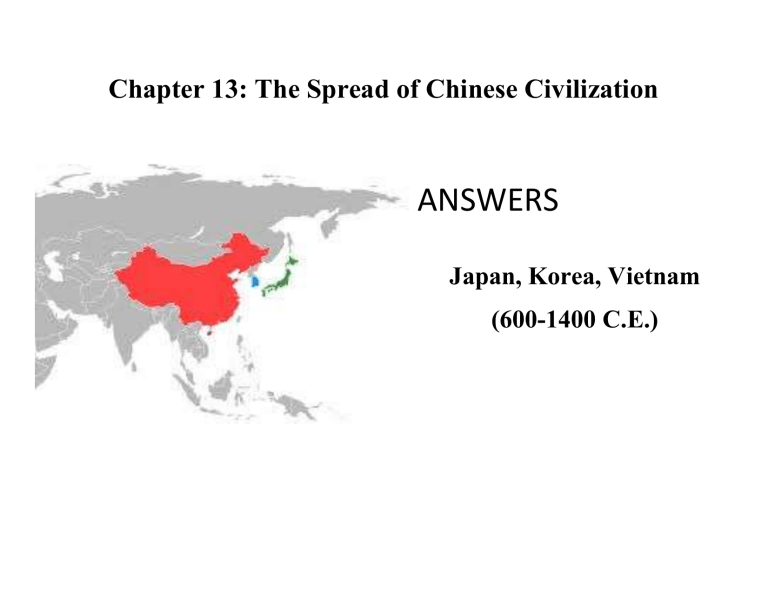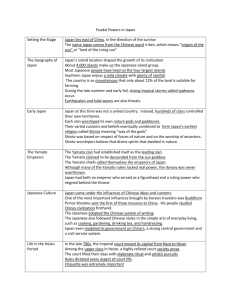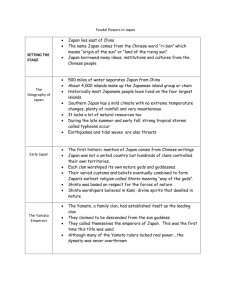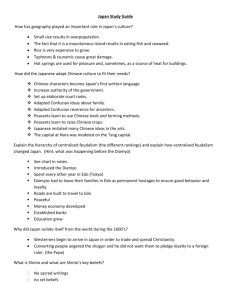Geography of Japan - Holland Central School
advertisement

Chapter 13: The Spread of Chinese Civilization ANSWERS Japan, Korea, Vietnam (600-1400 C.E.) Geography of Japan Geography o The nation is an archipelago or a group of islands under control over one government (4,000 islands) Approximate size = 146,000 square miles o Four major islands (north to south) Hokkaido Honshu Shikoku Kyusbu o Located 120 miles away from Korea, and 500 miles away from China Enabled area to import ideas from abroad without worrying about destruction of their own culture Contact between China and Japan resulted from both trade and warfare o Area is mountainous – 20% of land is arable Mountains are of volcanic origin o Located on the Ring of Fire Area at juncture between the Asian and Pacific tectonic plates Prone to earthquakes, typhoons. floods, and occasionally tidal waves. Geography of Japan Geography (continued) o Maintains temperate climate Approximate latitude as eastern seaboard of U.S. Slightly warmer on east coast Natural harbors provide protection to those living within this region Most of the population lives within region Early History of Japan Legendary Origins o Islands of Japan formed from marriage of the god Izanogi and goddess Izanami Gave birth to Japan Gave birth to sun goddess – Amaterasu Descendent became the founder of the Japanese nation. o Still believed into modern times First inhabitants o Islands inhabited by humans for at least 100,000 years o Jomon people Earliest Neolithic inhabitants (8,000 B.C.E.) Lived by hunting, fishing, and food gathering o Yayoi culture Immigrants from Korea who blended with Jomon people Majority of Japanese can trace ancestry to today Moved into Yamato plain during the first century C.E. Set up tribal society based on clans, known as uji. Early History of Japan Religion o Early Japanese worshipped kami Spirits who resided in trees, rivers and streams, and mountains Believed in ancestral spirits who were present in te atmosphere o Shintoism Also known as the “Way of the gods,” or Sacred Way Evolution of various kami and ancestral spirits into a state religion Serves as ideological and emotional force hat knits Japanese into a single people Focuses on the beauty of nature and respect for nature Imperial Japan Yamato Period (250-710 C.E.) o Yamato uji became the strongest of all the clans in Japan o Claimed to be decendents frm the sun goddess Amaterasu. Addressed themselves as the emperors of Japan As a result, there has been only one ruling family in Japan throughout its entire history At time, others ruled in the name of the emperor (made Yamato a figurehead). However, the same family sits as emperor today. Divinity officially recognized during Nara Period (710-794 C.E.) o Shotoku Taishi (Prince Shotoku (574-622 C.E.) Served as regent under Yamato rule Set up first major correspndence between Japan and China Sent missions to Tang capital of Chang’an to learn political institutions Devised Seventeen Article Constitution Created a centralized government under a supreme ruler o Gave legitimacy to Yamato rule o Taika reforms Further borrowed ideas on government from Chinese model Included farm ownership by state and similar bureaucracy o Buddhism blossoms in Japan from interactions with Chinese Imperial Japan Yamato Period (250 – 710 C.E.) con’t o Buddhism in Japan Originally introduced to Japan from Korea Became highly influential amongst aristocracy following missions to Tang China Idea of gaining peace through meditation appealed to Japanese Nara Period (710 – 794 C.E.) o High point of Chinese influence in Japan o Capital of Japan moved to the city of Nara City design based on Tang capital at Chang’an o Period Yamato rulers claimed themselves as the “Son of Heaven” o Height of Buddhism learning o End of period marked by a loss of Chinese influence Tadaiji Buddhist Temple in Nara. Largest wooden structure on earth Imperial Japan Heian Period (794-1185 C.E.) o Moved capital back to original power based at Heian (present day Kyoto) o Power held by the Fujiwara family (Emperor = figurehead) o Eliminated missions to Tang China o Focused on development of Japanese culture and ideas Ex. Tale of Genji – world’s first novel written by woman Murasaki Shikubu about life in the Heian court o Period marked by a decentralization of government Powerful families, known as Shoen, acquired great wealth through ownership of tax-exempt farmland Worked out deal with court aristocrats to avoid taxation Samurai class created to protect land interests o Samurai Military retainer class Lived life of simplicity and self-sacrifice Followed strict code of honor known as bushido (“way of the warrior”) Japan Under the Shogun Kamakura Shogunate (1192-1333 C.E.) o Emerged at the end of the 100s as rivalries amongst noble families led to constant civil war o Minamoto Yoritomo (1142-1199 C.E.) Given the title of Shogun – “supreme general of the Emperor’s army”, in 1192 C.E. From 1192 to 1867 C.E. the Shogun will have true power in Japan While the Emperor remained in Heian (Kyoto), the Shogun would move his power based to the city of Kamakura Created a bakufu (centralized government) under Shogun title Mongol conflicts (1274 C.E. and 1281 C.E.) Proved power of Shogun Began when Japan refused to pay tribute to Kublai Khan in 1266 C.E. Defeated Mongol army of 30,000 in 1274 C.E. Mongol army of 150,000 wiped out in 1281 C.E. after two months of fighting and the massive typhoon (kamikaze) that wiped out most of their ships. Japan would not face an invasion on their land again until the U.S. forces entered the mainland in 1945 C.E. Overthrown by the Ashikaga clan in 1333 C.E. Japan Under the Shogun Ashikaga Shogunate (1333 – 1600 C.E.) o Unable to restore centralized power o Power of local aristocracy reached peak o Daimyo Heads of the great noble families of Japan Relied on Samurai for protection Owed loyalty to Shogun in principle o Onin War (1467 – 1477 C.E.) Led to the virtual disintegration of the shogunate Powerful aristocrats seized control over large territories Result – Japan enters its own warring states period that will last until the end of the 1500s. Japanese Feudalism (100s – 1867 C.E.) Japanese Feudalism o System of government where local peoples (nobles) were given land in exchange for military service and loyalty to higher class o Emperor still rule in name, but did not control country (no real power) o Power rested in the hands of the military strongmen o Small ruling class was superior to their subjects o All members of Japanese society had a defined place o Began with the Kamakura and would end with the Meiji Restoration in 1867 C.E. o Power of the Shogun would become more solidified under the reign of the Tokugawa beginning in the 1600s C.E. Japanese feudal structure (highest to lowest) o Emperor – stood at the top of society but considered a figurehead. o Shogun – military and political ruler of society o Daimyo – Wealthy, elite samurai who served the Shogun in protecting and ruling Japan o Samurai – small nobility class of warriors. Followed code of honor – bushido o Peasants – Produced food for all of Japan o Merchants – Although wealthier than peasants, viewed as the lowest for lack of contribution to society as a whole. Japanese Feudal Structure Japanese Culture Japanese borrowed selectively from abroad without destroying essential native elements Religion o Shintoism Known as “Way of the gods” Emphasis on respect for nature Blended in with Buddhism upon its arrival o Buddhism Became a part of Japanese courts in 500s C.E.; masses in 700s Pure Land Buddhism (Jodo) – popular amongst masses Zen Buddhism Emphasized austerity, self-discipline, and communion with nature Exerted significant influence during Warring States era Complements traditional beliefs in Japanese society Became important component of warrior code Language o Japan had no written language prior to Chinese o Used Chinese characters as phonetic symbols that were combined to form Japanese words Chinese characters could not ordinarily be used due to the multiple syllables of Japanese words Japanese Culture Literature o During early period, Japanese preferred to write in Chinese. This changed as Japan moved into the Heian period. o Poetry Combines traditional Japanese aesthetics, Zen, and the language itself Haiku Composed of seventeen syllables (lines 5-7-5) Focused on images of nature and appreciation of life o Novels Many written during the Kamakura era, focusing in heroic war tales of the warrior class o Role of women Did not possess full rights of male counterparts, but held significant role in society Guaranteed inheritance rights to property Could be divorced if not able to produce a male heir Aristocratic women prominent at court (ex. Murasaki Shikibu) Korea Geography o Peninsula located in East Asia Bordered by the Sea of Japan in the east, East China Sea to the south, and the Yellow Sea to the west o Area roughly the size of Minnesota o Located within close proximity to China (north) and Japan (east) o Mountainous terrain – only 20% of the land is arable Early Chinese influence o Took control of northern portion of Korea during the early Han dynasty o With decline of the Han, power shifted to local tribal leaders Three separate kingdoms emerge in Korea as a result Koguryo in the north Paekche in the southwest Silla in the southeast Early History of Korea Era of the Three Kingdoms (300s – 600s C.E.) o Kogurya, Paekche, and Silla became bitter rivals during this period o All accepted tributary status under China during the Era of Six Dynasties o Kingdom of Silla Emerged as the dominant power on the peninsula Forced Chinese rulers to withdraw from Korea Accepted tributary status under the Tang Temporarily united all of Korea Borrowed ideas from the Chinese on government Made Buddhism the unified state religion Power undermined by aristocracy o Result – plunged area into civil war after assassination of leader in 780 C.E. Korea Under Dynastic Rule Korya Dynasty (918 – 1392 C.E.) o Protected from invasion by weak Chinese dynasties during formation o Era of high achievement Buddhist monasteries flourished and controlled vast amounts of territory Buddhist Tripitaka was produced using woodblock printing Time period where Confucian themes began to predominate o Northern portion of kingdom seized by Mongols in the 1200s C.E. Became a tributary to the Yuan Dynasty Period of suffering for Korean people o Collapsed during the rise of the Ming in China Yi Dynasty o Yi Songye Military commander who defeated the Korya Dynasty in 1392 C.E. Vietnam Geography o Located on China’s southern frontier o Lands found on the eastern portion of the Indochinese peninsula o Borders present day countries f China, Laos, Cambodia, and Thailand o Earliest people practices irrigated agriculture in the Red River Delta Vietnam Early history and conflict o Unified as a state around 200 B.C.E. o Fought against the Qin Temporarily preserved independence upon Qin collapse Vietnam under the Han o Absorbed into Han dynasty around 180 B.C.E. o Trung Sisters Widows of local nobles who were executed by the Chinese Led a brief revolt against Han in 39 C.E. o Han officials began to intermarry with local nobility, forming a Sino-Vietnamese ruling class o For the next 1,000 years, China would have control of the Han Rise of the Great Viet Dai Viet o Overthrew China during the collapse of the Tang o Maintained cultural heritage despite long period of captivity o Expanded lands southward Defeated by Champa by 1400 C.E. Expanded to the Gulf of Siam by 1600 C.E. o Gave tribute under the Song Dynasty o Conflict against the Mongols Vietnamese capacity for guerilla warfare drove invaders out o Conflict against the Ming Ming had occupation over Vietnam for 20 years Drove out Ming by 1428 C.E. Created a strong sense of national identity Vietnamese Culture Government o Borrowed Confucian model of administering rule o King viewed as a symbol for Vietnamese independence o Initiated civil service exams to check on power of nobility Religion o Vietnamese traditional belief of spirit worship culturally diffused with Buddhism, Daoism, and Confucianism Language o Chu nom (southern characters) Devised to provide a written system for spoken Vietnamese Emerged in the 800s C.E. Created system total independent of Chinese forms Role of Woman o Confucian concept of family took hold during 1,000 year rule o Possessed more rights than Chinese in both practice and law ex. Permitted to own property and divorce o Had strong historical tradition of associating heroic women with the defense of the homeland ex. Trung Sisters







